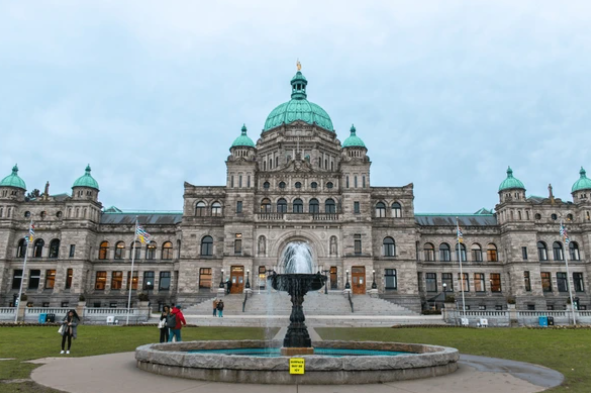Introduction: A New Chapter in Canada’s Expansion
The entry of British Columbia into the Canadian Confederation on July 20, 1871, was a significant milestone in the nation’s history, marking the expansion of Canada to the Pacific Coast. This event was not only crucial for the geographic and economic growth of Canada but also for the strategic consolidation of the young nation. British Columbia’s decision to join Confederation was influenced by a combination of economic pressures, political aspirations, and the promise of improved transportation and communication links with the rest of Canada.
The inclusion of British Columbia in the Confederation brought together diverse groups of people, including Indigenous nations, European settlers, and immigrants from around the world, into the Canadian fold. It also underscored the importance of infrastructure projects, such as the Canadian Pacific Railway, in the nation-building process. British Columbia’s entry into Confederation would shape the future of Canada’s development and strengthen its position as a transcontinental nation.
Read Also : Red River Rebellion (1870): A Struggle for Rights and Recognition
The Background: British Columbia Before Confederation
Before joining Confederation, British Columbia was a British colony with a unique history and development path, shaped by the fur trade, the gold rush, and its geographic isolation from the rest of British North America.
The Early Days: From Fur Trade to Gold Rush
British Columbia’s early history was dominated by the fur trade, which was the primary economic activity in the region for much of the 18th and early 19th centuries. The Hudson’s Bay Company (HBC) established trading posts along the coast and inland, forming the backbone of the region’s economy and facilitating interactions between European traders and Indigenous peoples.
The landscape of British Columbia changed dramatically with the discovery of gold in the Fraser River Valley in 1858, sparking the Fraser River Gold Rush. Thousands of prospectors from around the world, particularly from the United States, flooded into the region, leading to the rapid growth of settlements and the establishment of new infrastructure. The gold rush brought wealth and development but also created tensions between Indigenous peoples and settlers, as well as between British authorities and the predominantly American miners.
In 1858, the British government established the Colony of British Columbia to assert control over the region and manage the influx of settlers. The colony’s boundaries were later expanded to include Vancouver Island, which had been a separate colony since 1849. The combined colony of British Columbia faced significant challenges, including economic instability, geographic isolation, and a lack of transportation infrastructure.
The Road to Confederation: Economic and Political Challenges
By the late 1860s, British Columbia was struggling with economic difficulties and mounting debt, largely due to the cost of building roads and other infrastructure during the gold rush. The collapse of the gold rush economy left the colony in a precarious financial position, and there were growing concerns about the colony’s ability to sustain itself without external support.
At the same time, there were increasing fears about the potential threat of American expansionism. The United States had recently purchased Alaska from Russia in 1867, and there was concern that British Columbia, with its proximity to the U.S. border, could become the next target of American territorial ambitions. The idea of annexation to the United States was popular among some British Columbians, particularly those with economic ties to the American West Coast.
Against this backdrop, the idea of joining the Canadian Confederation gained traction. The Dominion of Canada, established in 1867 with the union of Ontario, Quebec, New Brunswick, and Nova Scotia, was seen as a potential solution to British Columbia’s economic and security challenges. The promise of a transcontinental railway connecting British Columbia to the rest of Canada was a particularly attractive proposition, offering the potential for economic growth and improved communication.
The Confederation Debates: Weighing the Pros and Cons
The decision to join Confederation was not made lightly, and it involved extensive debates and negotiations within British Columbia and with the Canadian government. The colony’s leaders had to weigh the potential benefits of Confederation against the risks and challenges it might entail.
The Economic Argument: The Promise of a Railway
One of the most compelling arguments in favor of Confederation was the promise of economic benefits, particularly the construction of a transcontinental railway. The Canadian government, led by Prime Minister Sir John A. Macdonald, offered British Columbia a significant incentive: the construction of the Canadian Pacific Railway (CPR), which would link the province to the rest of Canada and facilitate trade, transportation, and communication.
The railway was seen as essential for the economic development of British Columbia, which was geographically isolated from the rest of Canada and heavily reliant on maritime trade with the United States. The construction of the CPR promised to open up new markets, attract settlers, and stimulate economic growth in the region. It also provided a strategic link that would strengthen British Columbia’s ties to the Canadian Confederation and reduce its dependence on the United States.
The Political and Social Considerations
In addition to economic considerations, there were also important political and social factors that influenced the Confederation debate. Many British Columbians were concerned about maintaining their political autonomy and ensuring that their interests would be represented in the federal government. The colony’s leaders sought guarantees of political representation in the Canadian Parliament, as well as assurances that British Columbia’s unique legal and social systems would be respected.
There were also concerns about the impact of Confederation on British Columbia’s Indigenous populations, who had not been consulted in the negotiations. The colony’s Indigenous peoples had longstanding land claims and rights that were often ignored or overlooked by colonial authorities, and there was fear that their situation could worsen under Canadian rule. Despite these concerns, Indigenous voices were largely excluded from the formal Confederation debates, reflecting the broader marginalization of Indigenous peoples in the Canadian Confederation process.
The Annexation Debate: A Close Call
One of the most significant challenges to the Confederation movement in British Columbia was the debate over annexation to the United States. The idea of joining the United States had significant support among some segments of the population, particularly those who had economic ties to the American West Coast or who believed that American annexation would bring greater economic opportunities and political stability.
The annexation movement gained momentum in the late 1860s, with petitions being circulated and public meetings held to discuss the possibility of joining the United States. However, the movement ultimately failed to gain enough support, as many British Columbians remained loyal to the British Crown and were wary of the potential consequences of annexation, including the loss of British legal protections and social institutions.
The promise of the Canadian Pacific Railway, combined with the desire to remain part of the British Empire, ultimately tipped the balance in favor of Confederation with Canada.
The Road to Union: Negotiations and the Terms of Confederation
The decision to join Confederation was formalized through a series of negotiations between British Columbia and the Canadian government, resulting in the Terms of Union that would govern the province’s entry into Canada.
The Negotiations
The negotiations between British Columbia and Canada began in earnest in 1870, with a delegation from the colony traveling to Ottawa to present their demands to the Canadian government. The delegation, led by Joseph Trutch, John Helmcken, and Robert Beaven, sought to secure favorable terms for British Columbia’s entry into Confederation, including financial assistance, political representation, and the construction of the Canadian Pacific Railway.
The Canadian government, eager to expand the Confederation to the Pacific Coast and secure British Columbia’s loyalty, was willing to make significant concessions. The negotiations were conducted in a spirit of compromise, with both sides recognizing the mutual benefits of the union.
The Terms of Union
The final Terms of Union, agreed upon in 1871, included several key provisions that addressed British Columbia’s concerns and provided the framework for its entry into Confederation:
- Railway Construction: The Canadian government committed to beginning the construction of the Canadian Pacific Railway within two years of British Columbia’s entry into Confederation and to completing the railway within ten years. This promise was a central factor in securing British Columbia’s agreement to join Confederation.
- Financial Assistance: The Canadian government agreed to assume British Columbia’s existing debt and provide annual financial assistance to the province. This financial support was intended to help British Columbia address its economic challenges and support infrastructure development.
- Political Representation: British Columbia was granted representation in the Canadian Parliament, with three seats in the Senate and six seats in the House of Commons. This representation ensured that British Columbia’s interests would be considered in the federal government.
- Land and Resources: The Terms of Union allowed British Columbia to retain control over its public lands and natural resources, providing the province with a degree of autonomy in managing its economic development.
The Terms of Union were approved by the British Columbia legislature in April 1871 and by the Canadian Parliament shortly thereafter. British Columbia officially became the sixth province of Canada on July 20, 1871.
The Aftermath: Building the Pacific Province
The entry of British Columbia into Confederation was a significant achievement, but it also marked the beginning of a new set of challenges and opportunities for the province and the nation.
The Construction of the Canadian Pacific Railway
One of the most important and ambitious projects following British Columbia’s entry into Confederation was the construction of the Canadian Pacific Railway. The railway was a monumental engineering feat that involved the construction of thousands of miles of track across some of the most challenging terrain in North America, including the Rocky Mountains.
The construction of the railway was fraught with difficulties, including labor shortages, financial challenges, and political controversies. The project also had significant impacts on Indigenous communities along the route, many of whom were displaced or had their lands disrupted by the construction.
Despite these challenges, the Canadian Pacific Railway was completed in 1885, linking British Columbia to the rest of Canada and fulfilling the promise made during the Confederation negotiations. The railway played a crucial role in the economic development of British Columbia, facilitating the movement of goods and people and opening up new markets and opportunities.
The Growth and Development of British Columbia
Following its entry into Confederation, British Columbia experienced significant growth and development. The construction of the railway and the influx of settlers and investment helped to transform the province’s economy, with new industries such as logging, fishing, and mining emerging as key drivers of growth.
The province’s population grew rapidly, fueled by immigration from other parts of Canada, the United States, and overseas. The city of Vancouver, founded in 1886, quickly became the economic and cultural hub of the province, serving as a gateway for trade and commerce with Asia and the Pacific.
At the same time, British Columbia faced ongoing challenges related to the treatment of Indigenous peoples, who continued to be marginalized and excluded from the benefits of economic development. The province’s Indigenous populations, who had not been consulted during the Confederation negotiations, continued to press for recognition of their land rights and cultural autonomy.
The Legacy of British Columbia’s Confederation
The entry of British Columbia into the Canadian Confederation was a significant milestone in the nation’s history, with lasting implications for the development of the province and the country as a whole.
Strengthening Canada’s National Identity
The inclusion of British Columbia in Confederation helped to strengthen Canada’s national identity and solidify its status as a transcontinental nation. The completion of the Canadian Pacific Railway, linking the Atlantic and Pacific coasts, was a symbol of Canada’s unity and ambition, and it played a key role in shaping the country’s economic and political future.
The expansion of Confederation to the Pacific Coast also underscored Canada’s commitment to building a diverse and inclusive nation, capable of accommodating different regions, cultures, and peoples within a single political framework.
The Ongoing Struggles of Indigenous Peoples
The legacy of British Columbia’s entry into Confederation is also marked by the ongoing struggles of Indigenous peoples in the province. The exclusion of Indigenous voices from the Confederation process and the failure to address their land rights and cultural needs have had lasting consequences, contributing to a history of marginalization and conflict.
In recent years, there has been a growing recognition of the need to address the injustices faced by Indigenous peoples in British Columbia and across Canada. Efforts to promote reconciliation, recognize Indigenous rights, and address historical grievances are ongoing, and they remain an important part of the legacy of British Columbia’s Confederation.
Conclusion: Reflecting on British Columbia’s Entry into Confederation
The decision of British Columbia to join the Canadian Confederation in 1871 was a momentous event that had far-reaching consequences for the province and the nation. The inclusion of British Columbia in Confederation marked the expansion of Canada to the Pacific Coast, strengthened the nation’s unity, and set the stage for the development of a transcontinental country.
The legacy of British Columbia’s Confederation is complex, reflecting both the achievements and challenges of nation-building in Canada. While the entry of British Columbia into Confederation brought economic growth, political stability, and national unity, it also highlighted the need for ongoing efforts to address the rights and needs of Indigenous peoples and other marginalized communities.
As Canada continues to evolve and grow, the lessons of British Columbia’s Confederation remain relevant, reminding us of the importance of dialogue, compromise, and inclusivity in building a strong and just nation.
FAQ About British Columbia’s Entry into Confederation (1871)
Why did British Columbia join the Canadian Confederation?
British Columbia joined the Canadian Confederation in 1871 due to a combination of economic challenges, the promise of the Canadian Pacific Railway, concerns about American expansionism, and the desire for political stability and financial support from the Canadian government.
What were the Terms of Union for British Columbia’s entry into Confederation?
The Terms of Union included several key provisions: the construction of the Canadian Pacific Railway, financial assistance from the Canadian government, political representation in the Canadian Parliament, and control over public lands and natural resources by the province of British Columbia.
What impact did the Canadian Pacific Railway have on British Columbia?
The Canadian Pacific Railway played a crucial role in the economic development of British Columbia, linking the province to the rest of Canada and facilitating trade, transportation, and immigration. The railway also helped to strengthen national unity and consolidate Canada’s position as a transcontinental nation.
How did British Columbia’s entry into Confederation affect Indigenous peoples?
Indigenous peoples in British Columbia were largely excluded from the Confederation negotiations, and their land rights and cultural needs were not adequately addressed. The legacy of this exclusion has had lasting consequences, contributing to the marginalization of Indigenous communities and ongoing struggles for recognition and justice.
What is the legacy of British Columbia’s entry into Confederation?
The legacy of British Columbia’s entry into Confederation includes the expansion of Canada to the Pacific Coast, the economic and political development of the province, and the ongoing challenges related to Indigenous rights and reconciliation. The event remains a significant chapter in Canada’s history and continues to influence the nation’s development.







Thanks for posting. I really enjoyed reading it, especially because it addressed my problem. http://www.hairstylesvip.com It helped me a lot and I hope it will help others too.